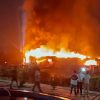Goa is abuzz with excitement as vintage bike and car owners, users, collectors and fans are decking […]

BJP INCITING COMMUNAL PASSIONS! BY AJOY ASHIRWAD MAHAPRASHASTA
Feb 19- Feb 25 2022, In the News February 18, 2022POLARISATION: The BJP is alleged to be polarising the voters in Uttar Pradesh along communal lines in the hope that the minorities will be isolated.
By Ajoy Ashirwad Mahaprashasta
In the campaign for the ongoing elections in India’s largest state Uttar Pradesh, Narendra Modi is demonizing the minority Muslim community while the Samajwadi party and AAP are stressing on social justice.
On a day when Samajwadi Party president Akhilesh Yadav at a rally promised to conduct a caste census within three months if voted to power, Prime Minister Narendra Modi while addressing a gathering in Kanpur Dehat attempted to pivot the election campaign towards issues of Hindutva.
Referring to a conversation Trinamool Congress MP Mahua Moitra had with Times of India recently, he said opposition ranks were trying to prevent “Hindu consolidation”. He said that the Election Commission of India should take note of a remark by Moitra that her party TMC tied up with “one party” in Goa to “divide Hindu votes”.
“Is this democracy? You are openly saying you want to divide the Hindu votes. Then whose votes are you trying to gather,” he asked, urging voters of Goa and Uttar Pradesh to bury such a “political mindset”.
On the other hand, Samajwadi Party has focussed its campaign around economic distress and promised a range of welfare programmes, including restoration of the old pension scheme, cost-free electricity for agricultural purposes and opening up job vacancies in the government. At the same time, it has attempted to stitch together a broad-based social alliance of different OBC groups, Dalits, minorities and a section of Brahmins by accommodating smaller, regional allies.
The Bahujan Samaj Party has also raised similar issues of distress while attempting to weave a larger communitarian coalition of Dalits, Muslims and some sections of “upper” caste groups. In fact, BSP supremo Mayawati on Monday, February 14, spoke about the “casteist, pro-capitalist” tendencies of the Adityanath government at a rally in the Jalaun district of Uttar Pradesh.
The saffron party, on the other hand, has majorly relied upon an aggressive Hindutva plank, mixed with doses of nationalism. With discontent over economic distress palpable across Uttar Pradesh, much of the saffron party’s development rhetoric has not stuck with a large section of the electorate.
Thus, Modi’s remark as well as Akhilesh Yadav’s emphasis on the caste census revealed the key fault lines in Uttar Pradesh: social justice politics pitched against Hindu communalism.
It may be noted that a large section of OBC leaders recently quit the BJP to join the SP, which has emerged as the primary challenger to the saffron party. Many of them – especially Swami Prasad Maurya and Om Prakash Rajbhar who deserted the NDA a few years ago – alleged that the Adityanath government has deliberately undermined issues like demand for a caste census or OBC sub-categorisation that have the potential to reveal inequality among OBC groups. The upper-caste tilt of the BJP, they said, is what suffocated them in the NDA.
BJP’s desperate attempts to polarise election
Well-aware of the impact that the opposition’s social justice rhetoric may have on marginalilsed groups in Uttar Pradesh, Modi’s statement on Moitra’s remark clearly is aimed at pivoting the electoral debate towards Hindutva. It may be said that BJP’s dominant strategy hitherto missed in the first two phases where agrarian issues remained dominant in the political discourse.
Over the last few months, chief minister Adityanath, who has been battling a fair degree of anti-incumbency, has made a number of provocative statements to directly or indirectly target Muslims, with the sole intention to consolidate Hindus. However, compared to the 2017 assembly polls, a large section of the electorate seemed to rally behind the issues which the opposition has been raising in the run-up to the 2022 polls. It is not unusual if one finds even a BJP worker speaking about problems like joblessness, price rise, or agrarian distress.
It may be noted that a large section of OBC leaders recently quit the BJP to join the SP, which has emerged as the primary challenger to the saffron party. Many of them – especially Swami Prasad Maurya and Om Prakash Rajbhar who deserted the NDA a few years ago – alleged that the Adityanath government has deliberately undermined issues like demand for a caste census or OBC sub-categorisation that have the potential to reveal inequality among OBC groups. The upper-caste tilt of the BJP, they said, is what suffocated them in the NDA.
BJP’s desperate attempts to polarise election
Well-aware of the impact that the opposition’s social justice rhetoric may have on marginalilsed groups in Uttar Pradesh, Modi’s statement on Moitra’s remark clearly is aimed at pivoting the electoral debate towards Hindutva. It may be said that BJP’s dominant strategy hitherto missed in the first two phases where agrarian issues remained dominant in the political discourse.
Over the last few months, chief minister Adityanath, who has been battling a fair degree of anti-incumbency, has made a number of provocative statements to directly or indirectly target Muslims, with the sole intention to consolidate Hindus. However, compared to the 2017 assembly polls, a large section of the electorate seemed to rally behind the issues which the opposition has been raising in the run-up to the 2022 polls. It is not unusual if one finds even a BJP worker speaking about problems like joblessness, price rise, or agrarian distress.
Immediately after Modi’s speech, BJP MLA from eastern Uttar Pradesh’s Domariyaganj Raghavendra Singh was heard saying in a now-viral video that if he was re-elected, the Muslims would switch from skull caps to “tilak”.
Uttar Pradesh has been witness to such aggressive, communal politics for the last few decades. However, what has changed is that in the last few years is that the prime minister has led the campaign for religious polarisation, bringing us back to the question of whether Moitra actually said what Modi passed on to the gathering.
Responding to the comment, Mahua Moitra likened Modi with “saffron sahibs” and alleged that they are “masters of twisting the truth” to suit their own political interests. The Wire could check her original statement.
“We have prevented a consolidation of Hindu votes (in north Goa) by tying up with the MGP (Maharashtrawadi Gomantak Party),” she replied to a question on whether the new entrant TMC has split non-BJP votes in the coastal state.
Over the last seven years, the BJP’s primary plank has been to polarise the majority Hindus in elections by pitching them against Muslims through a twin plank of Hindutva and development-related issues. In Uttar Pradesh specifically, such religious polarisation has worked in favour of the saffron party. In fact, BJP in most states of north India has consistently retained its over 30% vote share – one-third of the electorate – despite occasional failures.
Against such a backdrop, every opposition party pitched against BJP has attempted to forge strategic alliances and chalk out new tactics to steer the election rhetoric towards livelihood issues to prevent communal polarisation fuelled by the saffron party.
Moitra’s response to TOI was made in such a political context in which she spoke about preventing consolidation of the majority community along religious lines, and bringing back the focus of elections towards governance and development issues. Her response reflected a characteristic opposition leader’s understanding of political practice at this moment.
Modi, however, chose to see it in a different light – and we know why















